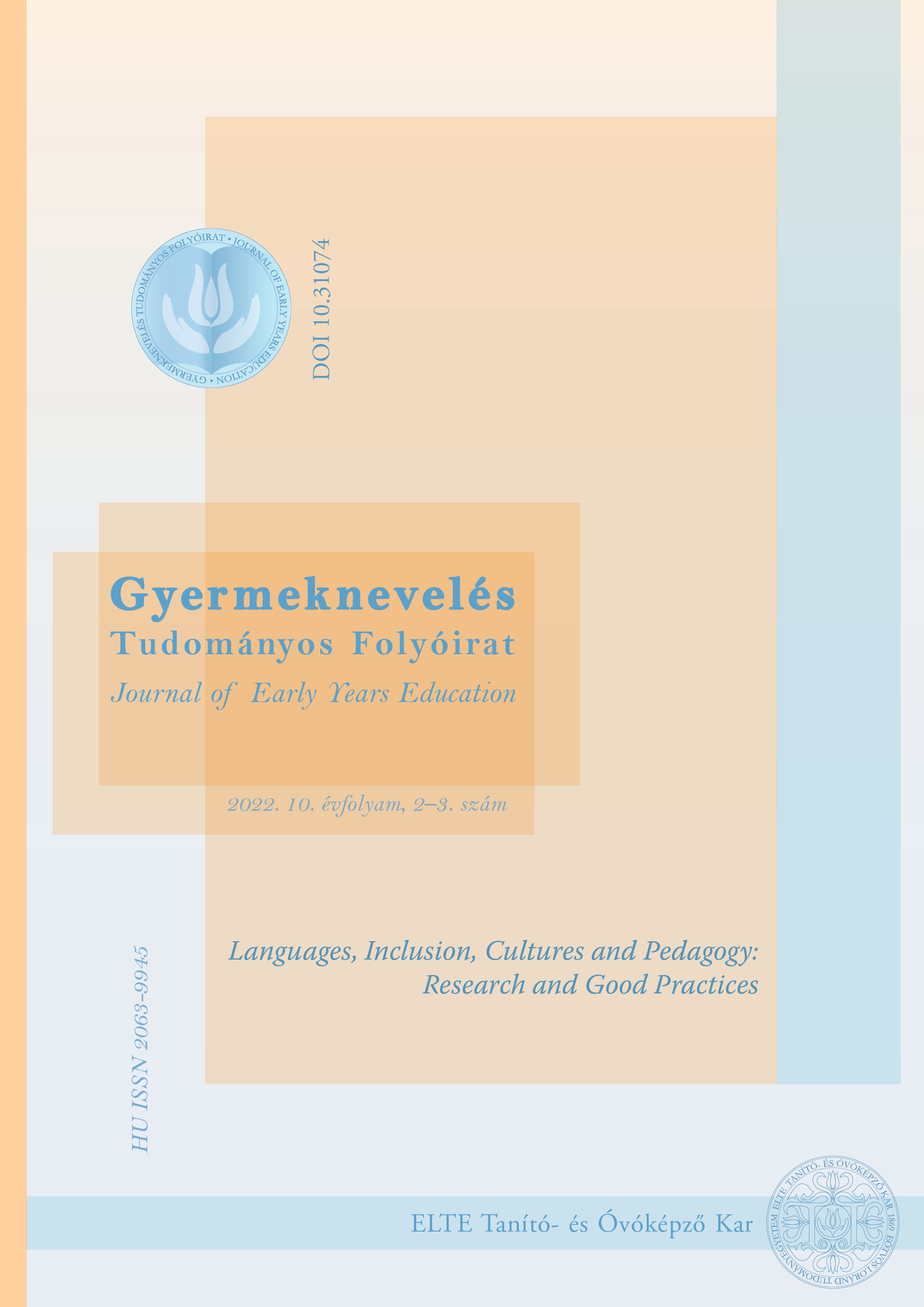Multicultural education in Hungarian daycares
DOI:
https://doi.org/10.31074/gyntf.2022.2.132.155Keywords:
multiculturalism, inclusion, daycare, early childhood educationAbstract
The subject of multicultural education remains largely unknown in Hungary despite the many, often volatile changes in everyday life that have arisen due to globalization and migration. This paper contends that children can be shown basic concepts related to multiculturalism, acceptance and tolerance within a daycare environment. The purpose of this study is twofold: while one aspect of this discussion explores to what degree Hungarian society is open to multiculturalism, the other examines what multicultural methods, topics or attitudes can be introduced to children attending daycare, a period that spans the ages of twenty weeks to three or four years old in Hungary. It is the authors’ general experience that Hungarian people are fairly open to the idea of multiculturalism, even though educational laws do not mention the importance of teaching multicultural ideas. To support or disprove this impression, a survey was conducted both in English and Hungarian to assess what the general public thinks about the topic of multicultural awareness in daycares. After analysing responses from the survey’s 105 participants, a practical session led by a daycare professional-in- training was then used to test the effectiveness of a playful, multicultural approach to introducing certain topics to three-year-old children.
Downloads
References
Balogh, L., Barbainé Bérci, I., Nyitrai, Á., Rózsa, J., Tolnayné Falusi, M. & Vokony, É. (2012). A bölcsödei nevelés-gondozás szakmai szabályai. Módszertani levél. Szociálpolitikai és Munkaügyi Intézet.
Kincses, Á. (2015). A nemzetközi migráció Magyarországon és a Kárpát-medence magyar migrációs hálózatai a 21. század elején. Központi Statisztikai Hivatal.
Erickson, F. (2001). A kultúra fogalma, elemei, értelmezési lehetőségei. In Tolgyik, J. (Ed.), Multikulturális tartalmak a pedagógiában (pp. 25–54). Educatio Társadalmi Szolgáltató Közhasznú Társaság.
Farkas, Z. (2005) A kultúra, a szabályok és az intézmények. Miskolci egyetem.
Godwyn, M. & Hoffer Gittel, J. (2012). Sociology of Organizations. Structures and Relationships. Pine Forge Press.
Gollnick, D. M. & Chinn, P. C. (2013). Multicultural Education in a Pluralistic Society. (9th ed.). Pearson Education.
Görbe, A. Z. K. (2013.) A migráció mint a magyar idegenrendészet XX. századi történetének sajátos területe. In Gaál, G. & Hautzinger, Z. (Eds.), A modernkori magyar határrendészet száztíz éve (pp. 193–208). Magyar Rendészettudományi Társaság Határrendészeti Tagozat. http://real.mtak.hu/80204/1/Amkorimrhr-188-203.pdf
Longley, R. (2019). What Is Multiculturalism? Definition, Theories, and Examples. Thought Co. https://www.thoughtco.com/what-is-multiculturalism-4689285
Malota, E. & Mitev, A. (2013). Kultúrák találkozása. Alinea Kiadó.
Mogyorósi, Zs. & Virág, I. (2015). Iskola a társadalomban – az iskolai társadalom. Líceum Kiadó.
Scheer, F. (2010, Ed.). „Ismerjük meg jobban egymást”. EIA/2009/3.3.I.I. Európai Integrációs Alap.
Websites
Apple Tree Kindergarten and Nursery. (2020, January 20). Apple Tree Kindergarten and Nursery. http://appletree-kindergarten.hu/
Arcanum Digitális Tudománytár (2020, February 22). Kultúra. Arcanum Adatbázis Kiadó. https://www.arcanum.hu/hu/online-kiadvanyok/Lexikonok-a-magyar-nyelv-ertelmezo-szotara-1BE8B/k-359B8/kultura-3985D/
Babóca Bölcsőde. (2020, January 20). Józsefvárosi Egyesített Bölcsődék. http://www.bolcsode-bp08.hu/baboca.html
na. (2004). Az oktatási minisztérium közleménye a külföldi állampolgár gyermekek, tanulók interkulturális pedagógiai rendszer szerinti óvodai nevelése és iskolai nevelése-oktatása irányelvének kiadásáról. Nemzeti Erőforrás Minisztérium.
EACEA National Policies Platform. (2021, February 25). Magyarország: A népesség, demográfiai helyzet, nyelvek, vallások. https://eacea.ec.europa.eu/national-policies/eurydice/content/population-demographic-situation-languages-and-religions-35_hu
ENAR. (n.d.). Válasz a Rasszizmusra Magyarországon. European Network Against Racism.
Eurostat. (2021, February 25). Migrációs statisztikák és a migráns népesség. https://ec.europa.eu/eurostat/statistics-explained/index.php?title=Migration_and_migrant_population_statistics/es
Habakukk Kindergarten and Nursery. (2020, January 20). Habakukk Kindergarten and Nursery. http://www.habakukk.hu/nursery-budapest
Happy Kids International Kindergarten and Nursery. (2020, January 20). Happy Kids International Kindergarten and Nursery. https://happykids.hu/
Józsefvárosi Egyesített Bölcsődék. (2020, February 28.). Tájékoztató a bölcsődei felvételi eljárásáról. Józsefvárosi Egyesített Bölcsődék. http://www.bolcsode-bp08.hu/jebdata/tajekoztato_bolcsodei_felvetelhez.pdf
Meaning of Culture in English. (2020, March 15). Cambridge University Press. https://dictionary.cambridge.org/dictionary/english/culture
Multiculturalism. (2020, April 10). https://en.wikipedia.org/wiki/Multiculturalism
Plum Pudding Óvoda/Kindergarten. (2020, January 20). Habakukk Kindergarden and Nursery. http://plumpudding.hu/home
Social Integration. (2020, April 10). https://en.wikipedia.org/wiki/Social_integration
Tájékoztató a bölcsődei térítési díj fizetéséről. (2018, August 1). Józsefvárosi Egyesített Bölcsődék. http://www.bolcsode-bp08.hu/jebdata/teritesi_dij.pdf
The English Garden. (2020, January 20). The English Garden. https://www.englishgarden.hu/en/
Under the Rainbow Kindergarten and Nursery. (2020, January 20). Under the Rainbow Kindergarden and Nursery. http://undertherainbow.hu/
Additional Files
Published
How to Cite
Issue
Section
License
Copyright (c) 2022 Author

This work is licensed under a Creative Commons Attribution-NonCommercial-ShareAlike 4.0 International License.

